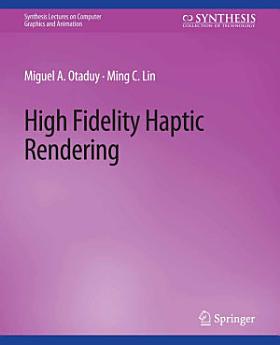High Fidelity Haptic Rendering
Miguel A. Otaduy · Ming C. Lin
2022年5月 · Springer Nature
电子书
103
页
report评分和评价未经验证 了解详情
关于此电子书
The human haptic system, among all senses, provides unique and bidirectional communication between humans and their physical environment. Yet, to date, most human-computer interactive systems have focused primarily on the graphical rendering of visual information and, to a lesser extent, on the display of auditory information. Extending the frontier of visual computing, haptic interfaces, or force feedback devices, have the potential to increase the quality of human-computer interaction by accommodating the sense of touch. They provide an attractive augmentation to visual display and enhance the level of understanding of complex data sets. They have been effectively used for a number of applications including molecular docking, manipulation of nano-materials, surgical training, virtual prototyping, and digital sculpting. Compared with visual and auditory display, haptic rendering has extremely demanding computational requirements. In order to maintain a stable system while displaying smooth and realistic forces and torques, high haptic update rates in the range of 500-1000 Hz or more are typically used. Haptics present many new challenges to researchers and developers in computer graphics and interactive techniques. Some of the critical issues include the development of novel data structures to encode shape and material properties, as well as new techniques for geometry processing, data analysis, physical modeling, and haptic visualization. This synthesis examines some of the latest developments on haptic rendering, while looking forward to exciting future research in this area. It presents novel haptic rendering algorithms that take advantage of the human haptic sensory modality. Specifically it discusses different rendering techniques for various geometric representations (e.g. point-based, polygonal, multiresolution, distance fields, etc), as well as textured surfaces. It also shows how psychophysics of touch can provide the foundational design guidelines for developing perceptually driven force models and concludes with possible applications and issues to consider in future algorithmic design, validating rendering techniques, and evaluating haptic interfaces.
作者简介
Miguel A. Otaduy is a post-doctoral research associate at the Computer Graphics Lab at ETH Zurich. He received a Ph.D. in Computer Science from the University of North Carolina at Chapel Hill in 2004, as the result of his work in haptic rendering of geometrically complex objects. He has published in the areas of haptic rendering, collision detection, and physically[1]based simulation of rigid and deformable objects. He has also served in the program committee of several international conferences, and has taught and organized tutorials on haptic rendering at the ACM SIGGRAPH and Eurographics conferences. He is currently a sub-project leader for the soft-tissue modeling cluster of the Swiss National Center of Competence in Research Co-Me (computational medicine). Ming C. Lin is a Professor of Computer Science in the University of North Carolina at Chapel Hill. She received her Ph.D. in Electrical Engineering and Computer Science from University of California at Berkeley. She is recognized worldwide for her research on haptic rendering and real-time physically-based interaction techniques for virtual reality and interactive 3D graphics. She has served as a program and conference chair of many international conferences, as an associate editor and guest editor of several journals in these areas, and as a steering committee member of ACM SIGGRAPH and Eurographics Symposium on Computer Animation and World Haptics Conference. She also co-edited the book, “Applied Computational Geometry”.
为此电子书评分
欢迎向我们提供反馈意见。
如何阅读
智能手机和平板电脑
笔记本电脑和台式机
您可以使用计算机的网络浏览器聆听您在 Google Play 购买的有声读物。
电子阅读器和其他设备
如果要在 Kobo 电子阅读器等电子墨水屏设备上阅读,您需要下载一个文件,并将其传输到相应设备上。若要将文件传输到受支持的电子阅读器上,请按帮助中心内的详细说明操作。





